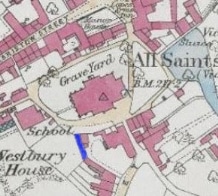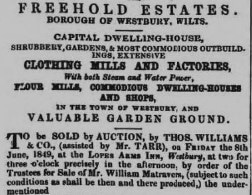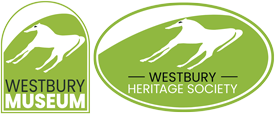The Matravers Family.
The Matravers family is remembered in the naming of our local senior school – but who were the Matravers and why were they important?
The family, who were associated with Westbury for more than 150 years, were Quakers and many are buried in the Quaker graveyard at the rear of Pinniger Finch in Church Street. But they were also prominent mill owners and employers, owning houses, land and mills around the town. The family fortunes suffered from the decline of the woollen industry in the 1840s.

The Quaker burial ground is the strip of landmarked red
The first references to the Matravers family in Westbury are in the seventeenth century, describing them as grocers or shopkeepers
When he died in 1765, he left a huge estate, and his will lists a large number of bequests to friends and family and demonstrates the extent of his holdings. The majority of his estate went to his only daughter Hester who went on to marry into local gentry – she married Lord William Seymour, brother to the Duke of Somerset.
Other family members forged connections with some of Westbury’s best-known families. Hester’s cousin Elizabeth Matravers married Gaisford Gibbs and her daughter Susanna married the younger Abraham Ludlow and had a daughter Susanna Gaisford Gibbs Ludlow who married Ralph Franco, the nephew of Westbury MP Mannaseh Massey Lopes (who built Westbury town hall). On the death of his uncle, Ralph inherited his estates and title, assuming the surname of Lopes – a familiar name in Westbury history.
Newly built Angel mill was operated in 1806 by the partnership of brothers John and William Matravers and Benjamin Overbury.

Hester Matravers
Over the next fifty years, the Matravers family, along with partners, owned or leased many local mills. These included Bitham Mill, Chalford Mill, Wellhead Mill, Great Hatch Mill, Angel Mill, Hawkeridge Mill and Town Mill. John died in 1814 and is the last of the Matravers family to be buried in the Quaker graveyard. He left funds not only for the Quakers but also £1000 for the establishment of a school for boys and girls in Westbury. He also left £1000 to provide clothing for 20 poor Westbury women.
The Matravers family wealth depended on the success of the mills – and by the early 1840s, cheap imports were beginning to take their toll on the economy of the West Wiltshire woollen industry.
By 1842 the closure of the mills and the decline in agricultural work was beginning to have a drastic effect on the population with William Matravers telling a public meeting that even before the mill closures “famine was already in the houses of the poor”.
These hard times reflected in the workhouse which was full to overflowing. In July 1842, the Wiltshire Independent newspaper was reporting the” distressed state of the poor” in Westbury due to the temporary closure of the Matravers and Overbury mills.

The sale of William’s estate at the Lopes Arms
By 1849, William Matravers, who then lived at Westbury House, sold much of his land, properties and mills. These included Hawkeridge Mill, Angel Mill, Bitham Mill, Wellhead Mill, water meadows, cottages, six houses on the Bratton Road, and houses and shops on the Warminster Road.
He also sold his family home Westbury House – now the town library – and moved to Church Street. His one surviving mill, known as Town Mill, was virtually destroyed in a huge fire in 1861. William left the town, moving to Melksham. He was buried in the Quaker graveyard at Melksham.

